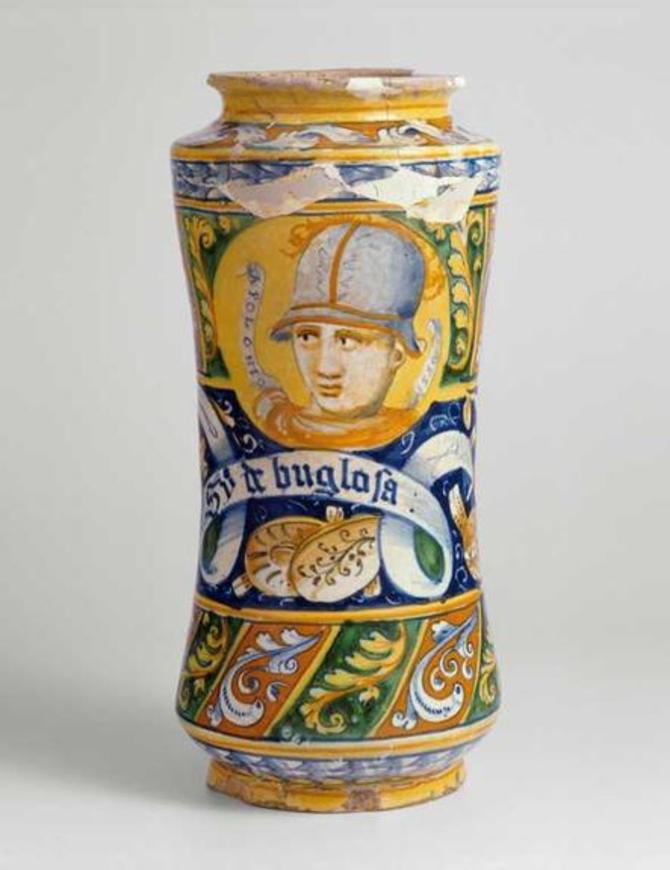This vase, made in Faenza, is known as a "grand feu" piece as its decoration is applied to the enamel before firing. The colours are obtained through the addition of metal oxides, a metal which changes in contact with air. The oxides, once mixed with enamel, will colour the fired product. Green is obtained thanks to copper oxides, blue from cobalt and yellow from antimony.
The vase's shape is reminiscent of a stick of bamboo. In the Middle Ages, these were used as containers for medicinal products from the Far East.
The central part of the vase is decorated a quartieri – in other words, with alternating quarters or compartments, presenting green or yellow backgrounds and plant motifs. A trofei, or trophy, decoration can also be seen. Here, it depicts an assembly of shields. Above, appears a three-quarter view of a helmeted man, whom an inscription names as Apollo. Greek god of the arts, he is also the god of doctors and healing.
Another inscription, written on a scroll, informs us of the content of this albarello. It reads "VHV SY DE BUGLOSA", which means "bugloss syrup". Bugloss is a medicinal plant which was used at that time, among other purposes, as a cold remedy.
This, therefore, is a vase representing the god of doctors and containing a medicine. It is, in fact, an apothecary jar! In Italian, it is referred to as an albarello.
Merchants at the time already understood the value of an aesthetically pleasing container when it came to selling their goods!

This vase, made in Faenza, is known as a "grand feu" piece as its decoration is applied to the enamel before firing. The colours are obtained through the addition of metal oxides, a metal which changes in contact with air. The oxides, once mixed with enamel, will colour the fired product. Green is obtained thanks to copper oxides, blue from cobalt and yellow from antimony.
The vase's shape is reminiscent of a stick of bamboo. In the Middle Ages, these were used as containers for medicinal products from the Far East.
The central part of the vase is decorated a quartieri – in other words, with alternating quarters or compartments, presenting green or yellow backgrounds and plant motifs. A trofei, or trophy, decoration can also be seen. Here, it depicts an assembly of shields. Above, appears a three-quarter view of a helmeted man, whom an inscription names as Apollo. Greek god of the arts, he is also the god of doctors and healing.
Another inscription, written on a scroll, informs us of the content of this albarello. It reads "VHV SY DE BUGLOSA", which means "bugloss syrup". Bugloss is a medicinal plant which was used at that time, among other purposes, as a cold remedy.
This, therefore, is a vase representing the god of doctors and containing a medicine. It is, in fact, an apothecary jar! In Italian, it is referred to as an albarello.
Merchants at the time already understood the value of an aesthetically pleasing container when it came to selling their goods!